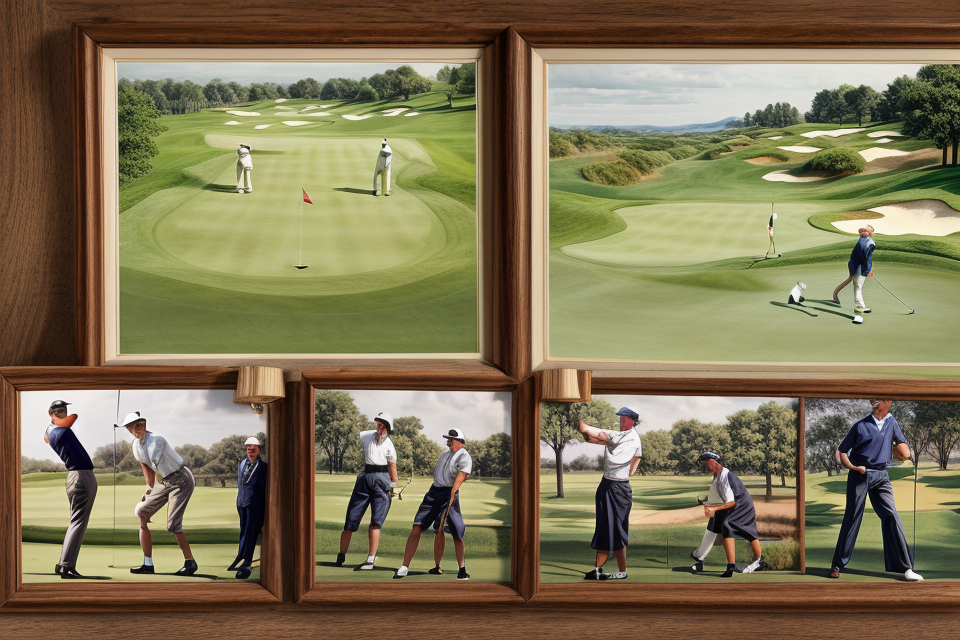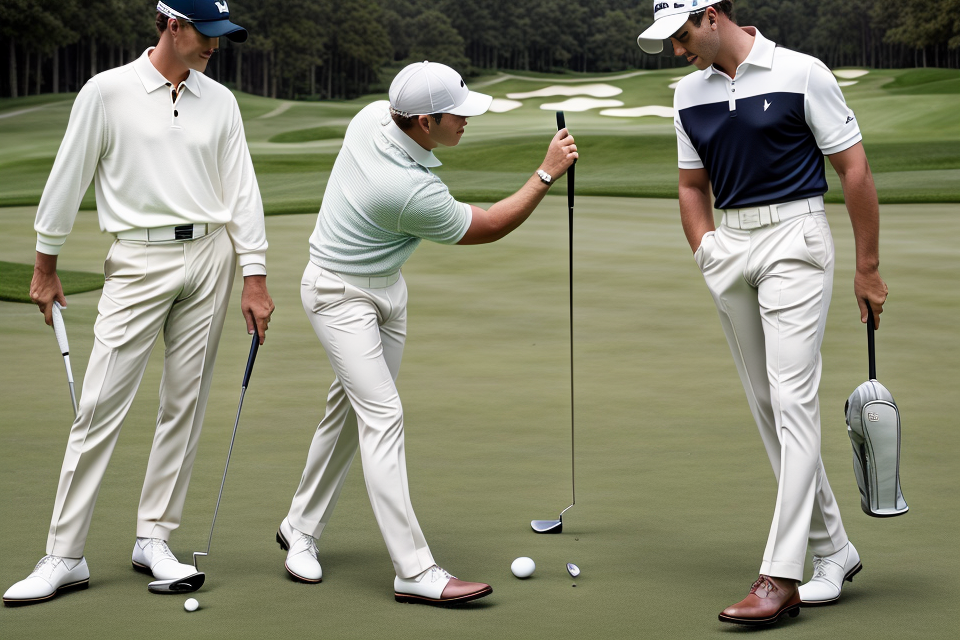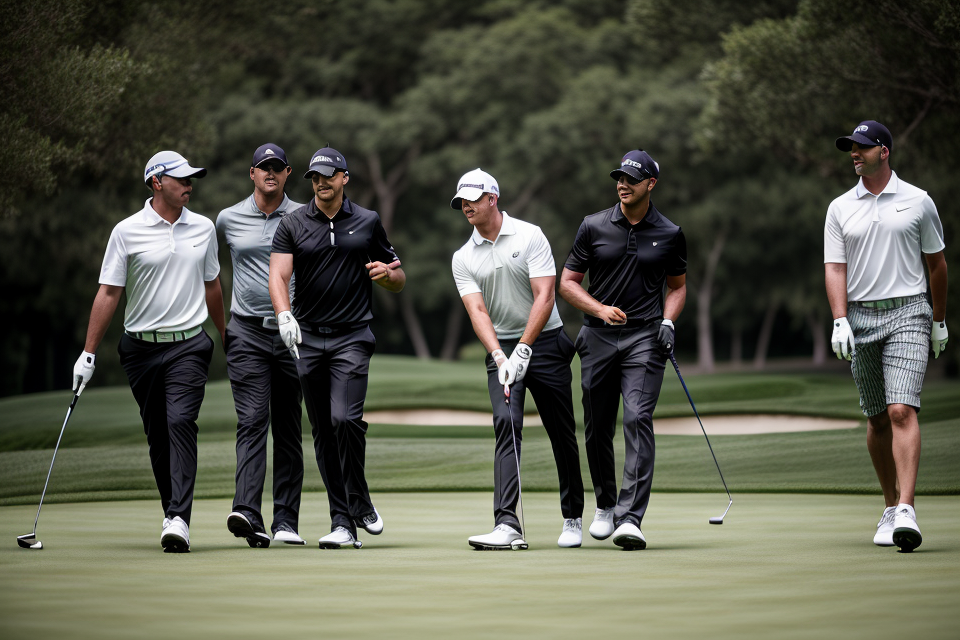
Golf attire has come a long way since its inception in the 18th century. The sport that was once played in baggy knickers and a tweed jacket has evolved into a more sophisticated and stylish game. As golf became more popular, so did the demand for more fashionable attire. This shift in golf fashion can be attributed to various factors such as the influence of celebrities, advancements in technology, and changes in societal norms. In this article, we will take a look at the historical overview of golf attire and when it changed. So, get ready to tee off into the world of golf fashion!
The Evolution of Golf Attire: A Brief Timeline
The Early Years: 1850s to 1900s
The Origins of Golf Attire
The origins of golf attire can be traced back to the early 1800s, when the sport was first introduced in Scotland. The earliest golfers wore everyday clothing, such as tweed jackets and trousers, and sometimes even wore hats and shoes with spikes to improve their grip on the ground.
The Emergence of Golf Clubs and Tournaments
As the popularity of golf grew, so did the need for more formal attire. Golf clubs and tournaments began to emerge, and with them came a need for a more uniformed look. In the late 1800s, golfers began to wear knickers, a type of knee-length pants that were popular at the time. They also began to wear collared shirts, often made of cotton or silk, and ties became a staple of the golf wardrobe.
The Impact of the Sport on Fashion
Golf had a significant impact on fashion during this time period. The sport’s growing popularity led to the development of new fabrics and materials, such as wool and cotton, which were used to create golf attire. The sport also led to the development of new styles and designs, such as the knickers and the collared shirt, which became staples of the golf wardrobe. Additionally, the need for comfortable and functional clothing led to the development of new technologies, such as waterproof and breathable fabrics, which have since become standard in golf attire.
The Transition Era: 1900s to 1950s
The Rise of Golf Apparel Manufacturers
During the early 1900s, golf apparel was primarily designed and crafted by individual tailors and small businesses. As the popularity of golf continued to grow, however, the demand for specialized golf attire increased, leading to the rise of dedicated golf apparel manufacturers. These companies, such as the famous “J. Press” in the United States, began to produce a wider range of golf-specific clothing items, including shirts, trousers, and outerwear.
The Impact of Hollywood and Pop Culture on Golf Fashion
As the film industry matured in the 1920s and 1930s, golfers began to see their favorite sport portrayed on the big screen. Movies like “The Hitchcock Hole” (1938) and “The Caddy” (1953) featured golfers dressed in stylish attire, further influencing the desires of everyday players. Pop stars like Frank Sinatra and Dean Martin, who were avid golfers, also contributed to the growing trend of golf fashion, often seen sporting the latest golf apparel in public appearances and performances.
The Evolution of Golf Course Design and Maintenance
Golf course design underwent significant changes during this period, with architects like Donald Ross and Alister MacKenzie revolutionizing the way courses were designed and maintained. Their innovative approaches to course design led to the creation of more challenging and visually appealing courses, which in turn inspired golfers to dress in attire that was both functional and stylish.
Overall, the transition era from the early 1900s to the 1950s was marked by the rise of golf apparel manufacturers, the influence of Hollywood and pop culture on golf fashion, and the evolution of golf course design and maintenance. These factors combined to create a new era of golf attire that was both practical and fashionable.
The Modern Era: 1950s to Present
The Birth of Golf Apparel as a Niche Market
During the 1950s, golf apparel began to emerge as a distinct market segment. Golfers started to recognize the importance of wearing appropriate clothing on the golf course, and manufacturers began to produce golf-specific garments to meet this demand. The golf apparel industry grew rapidly in the following decades, with a variety of clothing styles and materials becoming available to golfers.
The Influence of Technology on Golf Attire
In the 1980s and 1990s, advances in textile technology led to the development of high-performance fabrics specifically designed for golf apparel. These fabrics were lightweight, breathable, and moisture-wicking, providing golfers with greater comfort and mobility on the course. Manufacturers also began to incorporate new materials, such as spandex and polyester, into their designs to enhance flexibility and durability.
The Impact of Globalization on Golf Fashion
Globalization has had a significant impact on golf fashion in recent years. As golf has become more popular around the world, golfers from different cultures and countries have brought their unique fashion sensibilities to the sport. This has led to a greater diversity of golf attire styles, with designers incorporating elements from various cultures and fashion trends into their collections. Additionally, the growth of online retail has made golf apparel more accessible to golfers worldwide, allowing them to purchase a wider range of styles and brands.
The Role of Golf Attire in Golf Culture
The Importance of Golf Attire in Golf Etiquette
- Golf attire has always played a crucial role in golf culture and etiquette.
- Golfers have historically adhered to a dress code that reflects the sport’s tradition and professionalism.
- The dress code is not just about fashion; it also serves to maintain the sport’s integrity and traditions.
- The rules regarding golf attire can vary depending on the type of golf course and the specific event being played.
- Golfers are expected to dress appropriately for the occasion, and failure to do so can result in being asked to leave the course or even being disqualified from the tournament.
- Golf attire has evolved over time, with changes in materials, styles, and technology, but the importance of adhering to the dress code has remained constant.
- Golfers are expected to present themselves in a respectful and professional manner, regardless of their level of skill or experience.
- The dress code serves as a reminder of the sport’s rich history and traditions, and helps to maintain the sport’s reputation as a gentleman’s game.
The Relationship Between Golf Attire and Success on the Course
- The concept of dressing for success is not unique to golf culture. In many fields, individuals believe that dressing in a certain way can positively impact their performance.
- Golf attire has been influenced by broader cultural trends and changes in golf technology. As golf has become more accessible to a wider range of people, the dress code has become more relaxed.
- However, many golfers still believe that wearing the right clothing can improve their performance on the course. This belief is supported by research in psychology and sociology, which suggests that dressing in a certain way can influence one’s behavior and self-perception.
- For example, wearing a polo shirt and khakis may make a golfer feel more confident and put-together, which could lead to better focus and concentration on the course. On the other hand, wearing clothing that is too casual or uncomfortable could lead to distractions and decreased performance.
- The relationship between golf attire and success on the course is complex and multifaceted. While some golfers may believe that certain types of clothing are essential for success, others may feel that it is more important to wear clothing that is comfortable and practical. Ultimately, the choice of golf attire depends on the individual golfer’s preferences and beliefs.
The Impact of Golf Attire on Golf Course Design and Maintenance
- The Evolution of Golf Course Design:
- The emergence of golf courses as a popular recreational activity in the late 19th century led to the development of specific designs and layouts.
- The design of golf courses became more sophisticated over time, incorporating various features such as bunkers, water hazards, and green complexes to challenge players and enhance the overall golfing experience.
- Golf attire played a crucial role in shaping the design of golf courses by influencing the perception of players and their expectations regarding course aesthetics and accessibility.
- The Influence of Golf Attire on Golf Course Maintenance:
- Golf attire has also had an impact on the maintenance of golf courses, particularly in terms of dress codes and regulations.
- Many golf courses have established dress codes to maintain a certain level of etiquette and respect for the game, which can include restrictions on the type of golf attire allowed on the course.
- The adoption of golf attire with synthetic materials and advanced technologies has also influenced the maintenance of golf courses, as these materials and technologies require specific care and maintenance procedures to ensure optimal performance and longevity.
- The use of golf carts, for example, has become increasingly popular among golfers, which has led to the development of golf cart paths and the need for course maintenance crews to ensure that these paths are kept in good condition.
- Golf attire has also influenced the design of golf courses, as course architects take into account the needs and preferences of golfers when designing and maintaining golf courses.
- The popularity of certain types of golf attire, such as golf shoes with spiked or soft cleats, has influenced the design of golf courses by dictating the need for specific types of turf and ground cover that can withstand the wear and tear of golf shoes.
- Golf attire has also influenced the maintenance of golf courses by dictating the need for specific types of equipment and tools, such as golf cart washes and turf care equipment, to keep the courses in optimal condition.
Golf Attire Today: Trends and Innovations
The Latest Golf Apparel Trends
In recent years, golf apparel has seen a shift towards a more modern and functional aesthetic. Some of the latest trends in golf attire include:
- Performance-enhancing fabrics: Many golfers now prefer clothing made from moisture-wicking, breathable fabrics that help regulate body temperature and improve comfort during long rounds.
- Bold colors and patterns: Golfers are increasingly embracing more vibrant colors and bold patterns in their apparel, moving away from traditional neutrals and plaids.
- Sleek silhouettes: Today’s golfers favor apparel with a modern, streamlined look, including slim-fit pants and polo shirts, as well as updated takes on classic golf staples like the windbreaker and quarter-zip pullover.
- Sustainable materials: Environmentally conscious golfers are seeking out apparel made from sustainable materials, such as recycled polyester and organic cotton, which offer both style and eco-friendliness.
- Technological innovations: The latest golf apparel often incorporates technological features designed to enhance performance, such as stretchy, breathable fabrics with UV protection, and moisture-wicking linings.
The Impact of Sustainability on Golf Attire
Sustainability and Golf Apparel
- Eco-friendly materials
- Minimal waste production
- Energy-efficient manufacturing processes
The Role of Golf Apparel Manufacturers
- Incorporating sustainable practices
- Developing innovative eco-friendly materials
- Collaborating with environmental organizations
The Response from Golfers
- Increased demand for sustainable golf apparel
- Higher willingness to pay premium prices
- Environmental awareness driving purchase decisions
Future Outlook
- Continued focus on sustainability
- Emergence of new eco-friendly materials
- Integration of sustainable practices throughout the golf industry
The Future of Golf Attire: Emerging Technologies and Designs
Advanced Materials and Performance Apparel
As technology continues to advance, golf apparel is expected to incorporate innovative materials and designs that enhance performance and comfort. Some of the emerging trends in golf attire include:
- Moisture-wicking fabrics: These fabrics are designed to draw sweat away from the body, keeping golfers cool and dry during intense games. They are made from materials like polyester and nylon, which are lightweight and breathable.
- Stretch and flexibility: Modern golf attire often features fabrics with four-way stretch, which allows for a full range of motion during swings and other golf-related activities. This improves comfort and performance, enabling golfers to make the most of their skills.
- Anti-odor and anti-bacterial properties: Some golf apparel now includes special coatings or treatments that inhibit the growth of odor-causing bacteria. This helps keep clothing fresh and clean, even after multiple wears.
Smart Textiles and Wearable Technology
As the market for wearable technology continues to grow, golf apparel may start to incorporate smart textiles that offer a range of benefits. These could include:
- Biometric sensors: Integrated into golf apparel, these sensors could monitor a golfer’s heart rate, steps taken, and other vital signs during a game. This data could be used to optimize performance and track progress over time.
- Solar-powered charging: Solar-powered textiles could be used to charge mobile devices or other wearable technology, making it easier for golfers to stay connected and charged during a round.
- Virtual coaching: Smart textiles could be used to provide real-time feedback on a golfer’s swing, stance, and other aspects of their game. This data could be used to identify areas for improvement and track progress over time.
Sustainable and Eco-friendly Materials
As concerns about the environment continue to grow, many golf apparel manufacturers are exploring more sustainable and eco-friendly materials. Some examples include:
- Recycled materials: Golf apparel made from recycled materials helps reduce waste and conserve resources. This can include recycled polyester, nylon, and other synthetic fabrics.
- Organic cotton: Organic cotton is grown without the use of harmful pesticides and fertilizers, making it a more environmentally friendly option. It is also softer and more comfortable than conventional cotton.
- Bio-based materials: These materials are made from renewable resources like bamboo, soy, or other plant-based materials. They offer a more sustainable alternative to traditional synthetic fabrics.
Overall, the future of golf attire looks promising, with a range of emerging technologies and designs set to enhance performance, comfort, and sustainability. As these trends continue to evolve, golfers can expect to see a growing range of innovative and high-performance apparel options that meet their needs both on and off the course.
The Enduring Importance of Golf Attire in Golf Culture
- Golf Attire as a Symbol of Respect
- Golf attire serves as a symbol of respect for the game and its traditions.
- Players are expected to dress appropriately when playing, both to show respect for the game and to maintain a level of professionalism.
- Golfers who do not adhere to the dress code may be asked to leave the course or may be subject to other penalties.
- Golf Attire as a Fashion Statement
- Golf attire has also become a fashion statement, with many golfers using their clothing to express their personal style and sense of fashion.
- Many golfers today choose to wear clothing that is both functional and fashionable, with brands such as Nike, Adidas, and Under Armour leading the way in golf apparel.
- Golfers may also choose to accessorize their outfits with hats, belts, and other items, adding their own personal touch to their golf attire.
- Golf Attire as a Reflection of Status
- Golf attire can also be a reflection of one’s status or social standing.
- In some cases, golfers may choose to wear clothing that is more expensive or high-end, as a way of showing off their wealth or success.
- However, this is not always the case, and many golfers choose to wear clothing that is both functional and affordable, regardless of their social status.
- Golf Attire as a Means of Identification
- Golf attire can also serve as a means of identification, with many golfers choosing to wear clothing that is associated with their club or golfing association.
- This can help to foster a sense of community and belonging among golfers, and can also help to promote the game and its traditions.
- Golfers may also choose to wear clothing that is associated with their country or region, as a way of promoting their heritage and culture.
The Continuing Evolution of Golf Attire
The world of golf attire has witnessed a significant transformation over the years. With advancements in technology and changes in fashion trends, golfers today have access to a wider range of apparel options than ever before. Here’s a closer look at the continuing evolution of golf attire.
Performance-enhancing Gear
One of the most significant changes in golf attire has been the development of performance-enhancing gear. Golfers now have access to apparel that is designed to improve their game by providing enhanced comfort, flexibility, and breathability. For example, golfers can now wear moisture-wicking fabrics that keep them cool and dry during a round of golf, as well as apparel that provides support and stability during swings.
Style and Comfort
Another notable change in golf attire has been the increased focus on style and comfort. Golfers today expect their apparel to not only perform well on the course but also look good off the course. As a result, many golf apparel brands have shifted their focus towards creating stylish, yet functional, golf attire that offers both comfort and performance.
Sustainability
In recent years, there has been a growing trend towards sustainability in golf attire. Many golf apparel brands are now incorporating eco-friendly materials into their products, such as recycled polyester and organic cotton. Additionally, some brands are using more sustainable production methods, such as reducing water usage and energy consumption in their manufacturing processes.
Technology
Technology has also played a significant role in the evolution of golf attire. Advancements in materials science and manufacturing processes have led to the development of innovative new fabrics and designs that offer enhanced performance and comfort. For example, some golf apparel brands are now incorporating biometric sensors into their clothing to track a golfer’s performance and provide feedback on their swing.
In conclusion, the world of golf attire continues to evolve, with new trends and innovations emerging regularly. Whether it’s performance-enhancing gear, style and comfort, sustainability, or technology, golfers today have access to a wider range of apparel options than ever before. As the game of golf continues to grow and evolve, so too will the golf attire industry, with new and exciting developments on the horizon.
The Exciting Future of Golf Fashion
The world of golf fashion is constantly evolving, and there are many exciting developments on the horizon. With advancements in technology and an increased focus on sustainability, the future of golf attire looks bright. Here are some of the trends and innovations that are shaping the future of golf fashion:
Sustainable and Eco-Friendly Golf Apparel
As awareness about the environmental impact of fashion grows, there is a growing demand for sustainable and eco-friendly golf apparel. Many golf apparel brands are now using recycled materials, organic cotton, and other sustainable fabrics to create their products. Some brands are even exploring innovative techniques such as closed-loop recycling, which allows them to recycle and reuse materials indefinitely.
Smart Golf Apparel
Smart golf apparel is another exciting development in the world of golf fashion. These garments are designed with sensors and other technology that can track various aspects of a golfer’s performance, such as swing speed, distance, and accuracy. This data can be used to improve the golfer’s game and provide valuable insights into their technique.
Customizable Golf Apparel
Customizable golf apparel is also becoming increasingly popular. With the help of 3D printing and other advanced manufacturing techniques, golf apparel brands can now create garments that are tailored to the individual needs and preferences of each golfer. This allows golfers to create a truly personalized look that reflects their unique style and personality.
Virtual Reality and Augmented Reality in Golf Fashion
Virtual reality (VR) and augmented reality (AR) are two technologies that are rapidly transforming the world of golf fashion. With VR, golfers can experience what it’s like to play on different courses and in different conditions, without ever leaving their home. AR, on the other hand, can be used to enhance the golfing experience by providing real-time data and other useful information to golfers as they play.
Wearable Technology for Golfers
Wearable technology is another trend that is shaping the future of golf fashion. These devices can track various aspects of a golfer’s performance, such as their heart rate, distance, and swing speed. This data can be used to improve the golfer’s game and provide valuable insights into their technique.
Overall, the future of golf fashion looks bright, with many exciting developments on the horizon. As technology continues to advance and sustainability becomes a more important concern, golf apparel brands will need to adapt and innovate in order to meet the changing needs and preferences of golfers around the world.
FAQs
1. When did golf attire change?
Golf attire has undergone significant changes over the years. While the origins of golf can be traced back to Scotland in the 15th century, it was not until the late 19th century that golf attire began to evolve. The traditional golf attire of the time consisted of a jacket and tie, but this began to change in the 1880s as the game became more popular and accessible to a wider audience.
2. What influenced the change in golf attire?
The change in golf attire can be attributed to a number of factors. As golf became more popular, there was a greater emphasis on comfort and practicality. Golfers began to prefer clothing that allowed for greater freedom of movement, and this led to the development of new fabrics and designs. Additionally, the rise of sportswear and leisurewear in the early 20th century had a significant impact on golf attire, leading to the adoption of more casual and comfortable styles.
3. When did golfers start wearing polo shirts?
Polo shirts were first introduced to golf in the 1920s. They were initially worn as a more casual alternative to the traditional jacket and tie, and were popularized by American golfers. Polo shirts quickly became a staple of golf attire, and are now considered a classic and iconic part of the sport.
4. When did golfers start wearing shorts?
Golfers began wearing shorts in the 1930s, as a more comfortable and practical alternative to long pants. Initially, shorts were only worn by amateur golfers, but they quickly became popular among professionals as well. Today, shorts are a common sight on golf courses around the world, and are considered a staple of golf attire during the warmer months.
5. When did women start playing golf?
Women have been playing golf for over a century, with the first recorded female golfers dating back to the 1800s. However, it was not until the early 20th century that women’s golf became more popular and accessible. As women’s golf grew in popularity, so too did the demand for women’s golf attire, leading to the development of specialized clothing for female golfers.
6. When did golfers start wearing golf shoes?
Golfers have been wearing golf shoes for over a century, with the first golf shoes dating back to the early 1900s. The traditional golf shoe was a lace-up dress shoe, but as the game evolved, so too did the shoes. In the 1960s, spiked golf shoes were introduced, providing greater traction and stability on the golf course. Today, golf shoes are designed with a range of features to enhance performance, including spiked or studded soles, waterproof materials, and flexible designs.


